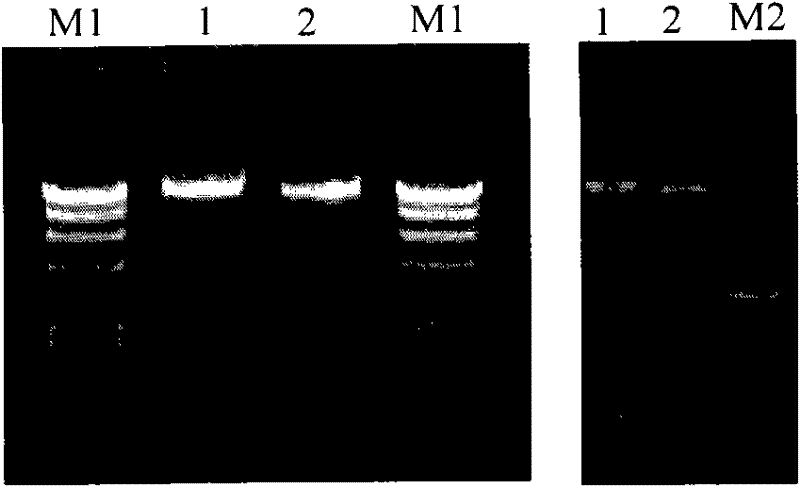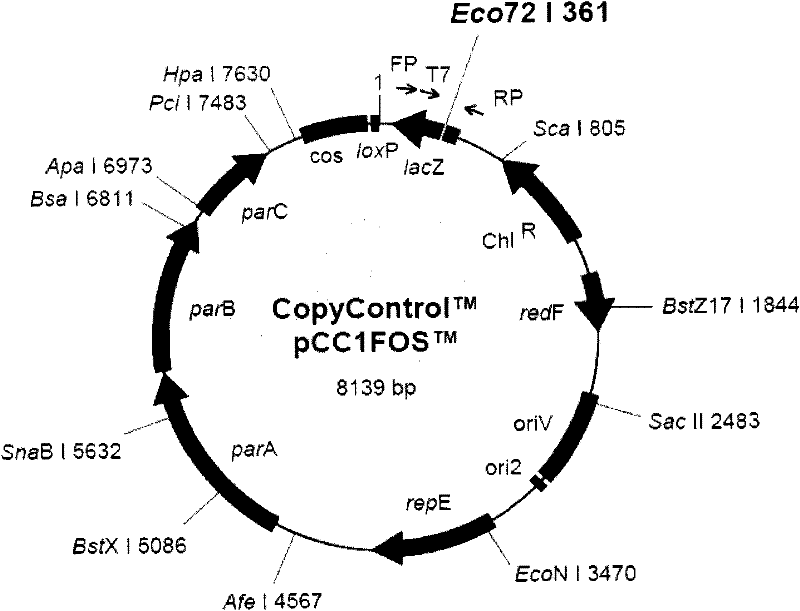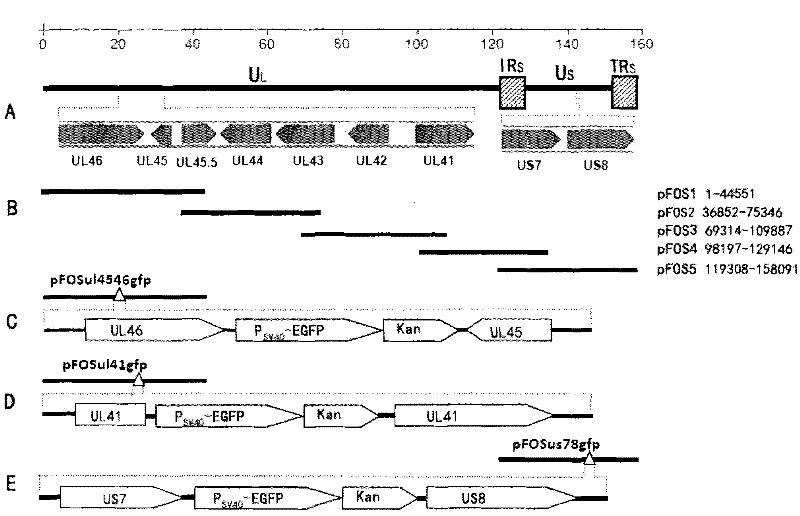Duck viral enteritis virus infectious recombinant cloning system and its construction method and application
A technology for duck viral enteritis, infectivity, applied in the field of infectious cloning of virus vaccine strains
- Summary
- Abstract
- Description
- Claims
- Application Information
AI Technical Summary
Problems solved by technology
Method used
Image
Examples
Embodiment 1
[0037] Example 1. Construction of Genome Fosmid Library of DEV Vaccine Strain
[0038] The Fosmid library of the DEV genome was constructed according to the instructions of the "CopyControl Fosmid Library Production Kit" kit from EPICENTRE. The method is as follows, the DNA of the DEV vaccine strain virus (CVCC AV1222) (GeneBank EU082088) (China Veterinary Microbiological Culture Collection Management Center, catalog number AV1222; purchased from the China Veterinary Drug Supervision Institute) DNA was physically used with a 25-gauge needle (purchased from Shanghai Zhiyu Medical Instrument Co., Ltd.) was pumped several times to cut the DNA fragments with T4DNA Polymerase (purchased from New England Biolabs) and alkaline phosphatase (Alkaline Phosphatase) (purchased from New England Biolabs). End smoothing and dephosphorylation treatment, pulse electrophoresis (with Bio-Rad CHEF The XA Pulsed Field system performs pulse electrophoresis, and the conditions of pulse electrophor...
Embodiment 2
[0039] Example 2. Selection for rescue of DEV cosmids
[0040] After the library was successfully constructed, 286 clones were picked to extract the cosmids, and the alkaline lysis method was used to [5] Extract the cosmid and send it to Dalian Bao Biological Co., Ltd. to sequence the end of the DEV DNA fragment inserted into pCC1 Fos. The sequences of the sequencing primers are as follows:
[0041] Primer 1: TAATACGACTCACTATAGGG
[0042] Primer 2: GCCAAGCTATTTAGGTGAGA
[0043] After terminal sequencing analysis, a total of 250 clones with complete FseI-SbfI-PmeI adapters connected to both ends of the insert fragment were obtained. Multiple sets of 5 cosmid combinations were selected from these 250 clones. Both ends of the DEV DNA fragments cloned in each group contain Fse I-Sbf I-Pme I joints, which can overlap each other and can be spliced to cover the entire DEV genome.
Embodiment 3
[0044] Example 3. Virus rescue
[0045] The DNA of the selected cosmids was extracted with Qiagen's medium extraction kit. The selected cosmids were linearized with Fse I, Sbf I or Pme I endonuclease (both purchased from New England Biolabs), and the reaction conditions were as follows: 20 U of Sbf I endonuclease (Fse I or Pme I could also be used Endonuclease), cosmid 10 μg, acted at 37°C for 1 hour, extracted with phenol / chloroform, and precipitated with ethanol to prepare DEV DNA for transfection.
[0046] Refer to the calcium phosphate method of Reddy SM (2002) to co-transfect the second generation chicken embryo fibroblasts (CEF) with 5 segments of DEV DNA [3] After multiple repetitions, 3 groups of 5-cosmid combinations showed typical lesions of DEV virus after 4-6 days of transfection. A group of 5-cosmid combinations with good repeatability was selected for subsequent experiments. The position of the cosmid combination relative to the DEV genome is as follows image...
PUM
 Login to View More
Login to View More Abstract
Description
Claims
Application Information
 Login to View More
Login to View More - R&D
- Intellectual Property
- Life Sciences
- Materials
- Tech Scout
- Unparalleled Data Quality
- Higher Quality Content
- 60% Fewer Hallucinations
Browse by: Latest US Patents, China's latest patents, Technical Efficacy Thesaurus, Application Domain, Technology Topic, Popular Technical Reports.
© 2025 PatSnap. All rights reserved.Legal|Privacy policy|Modern Slavery Act Transparency Statement|Sitemap|About US| Contact US: help@patsnap.com



